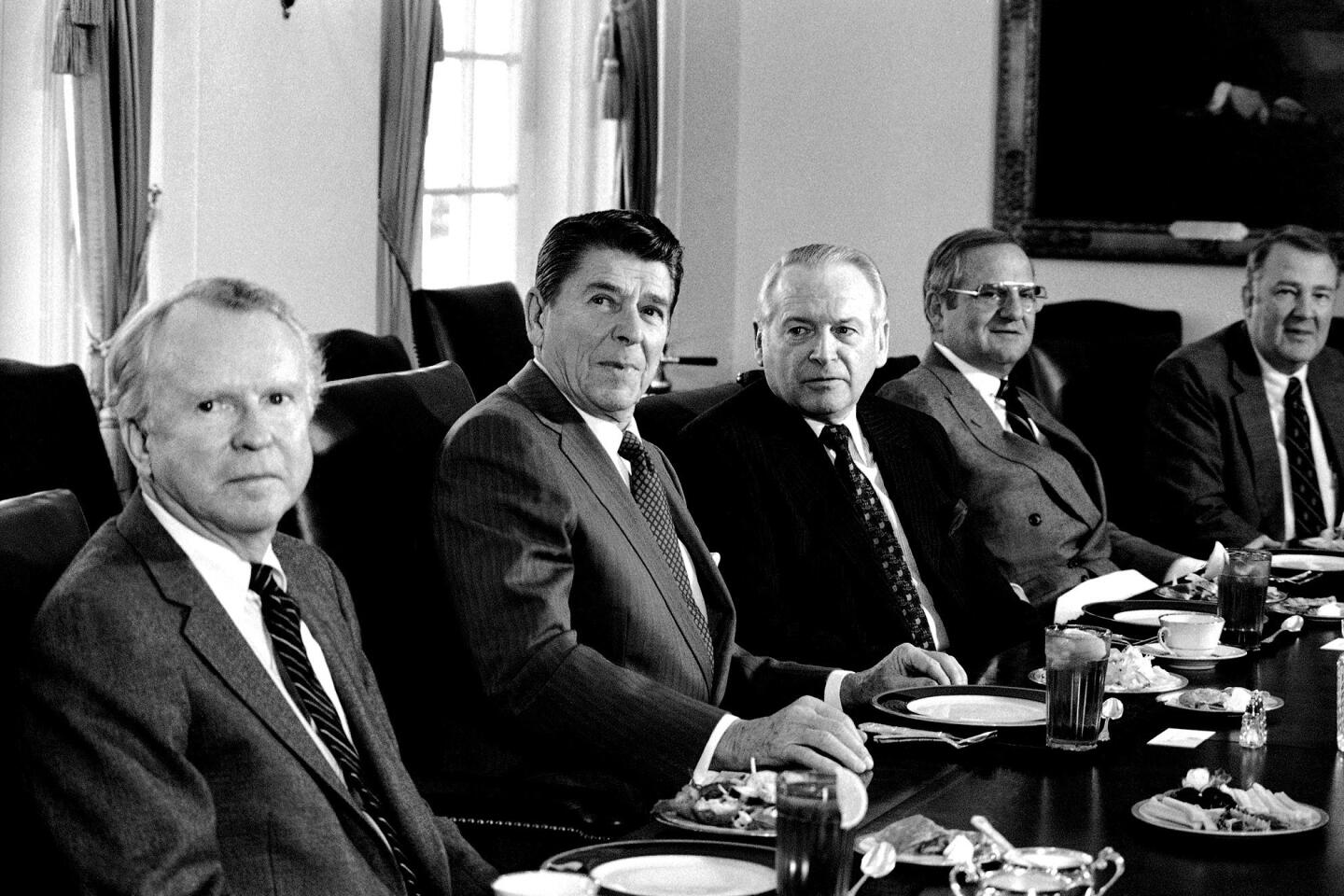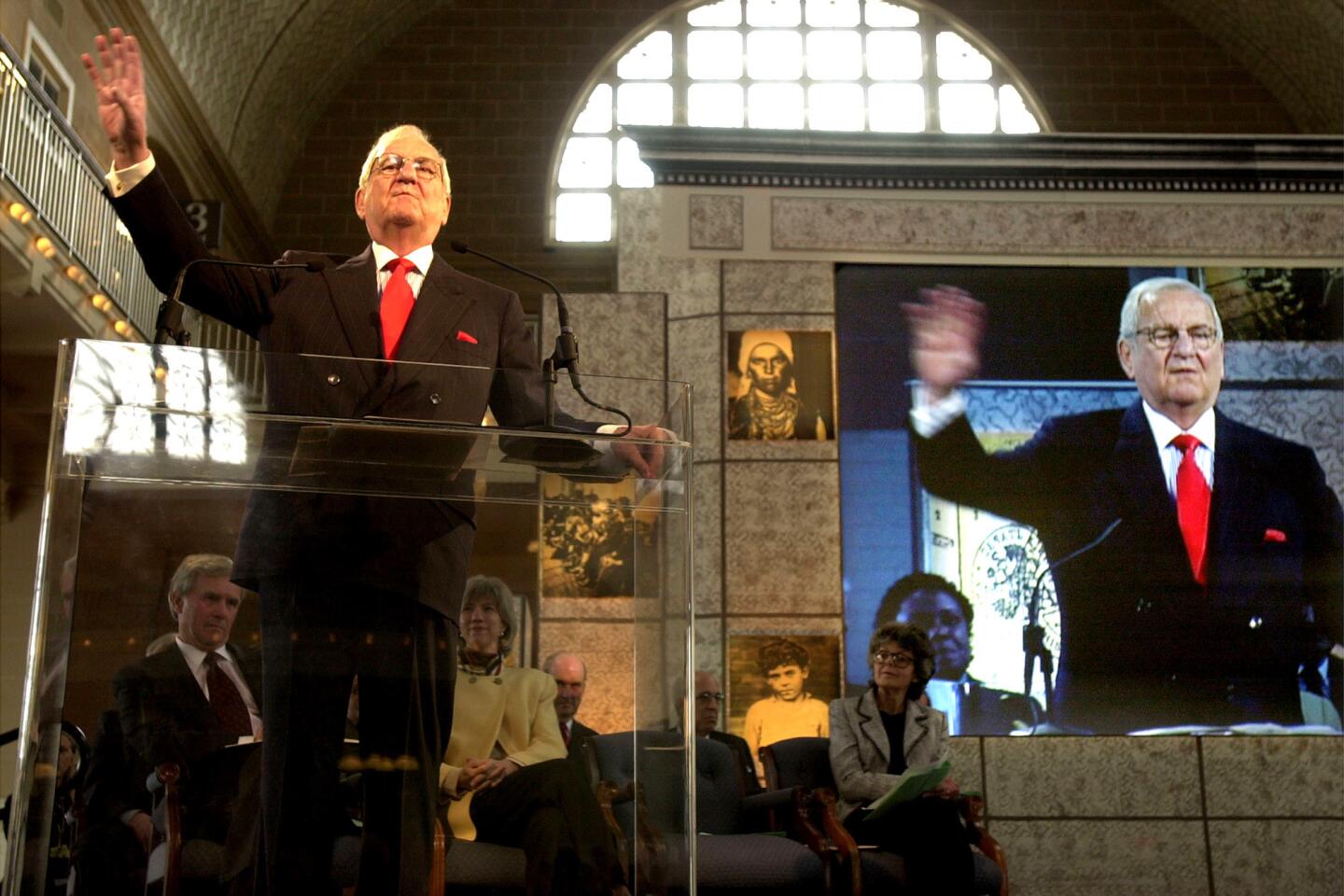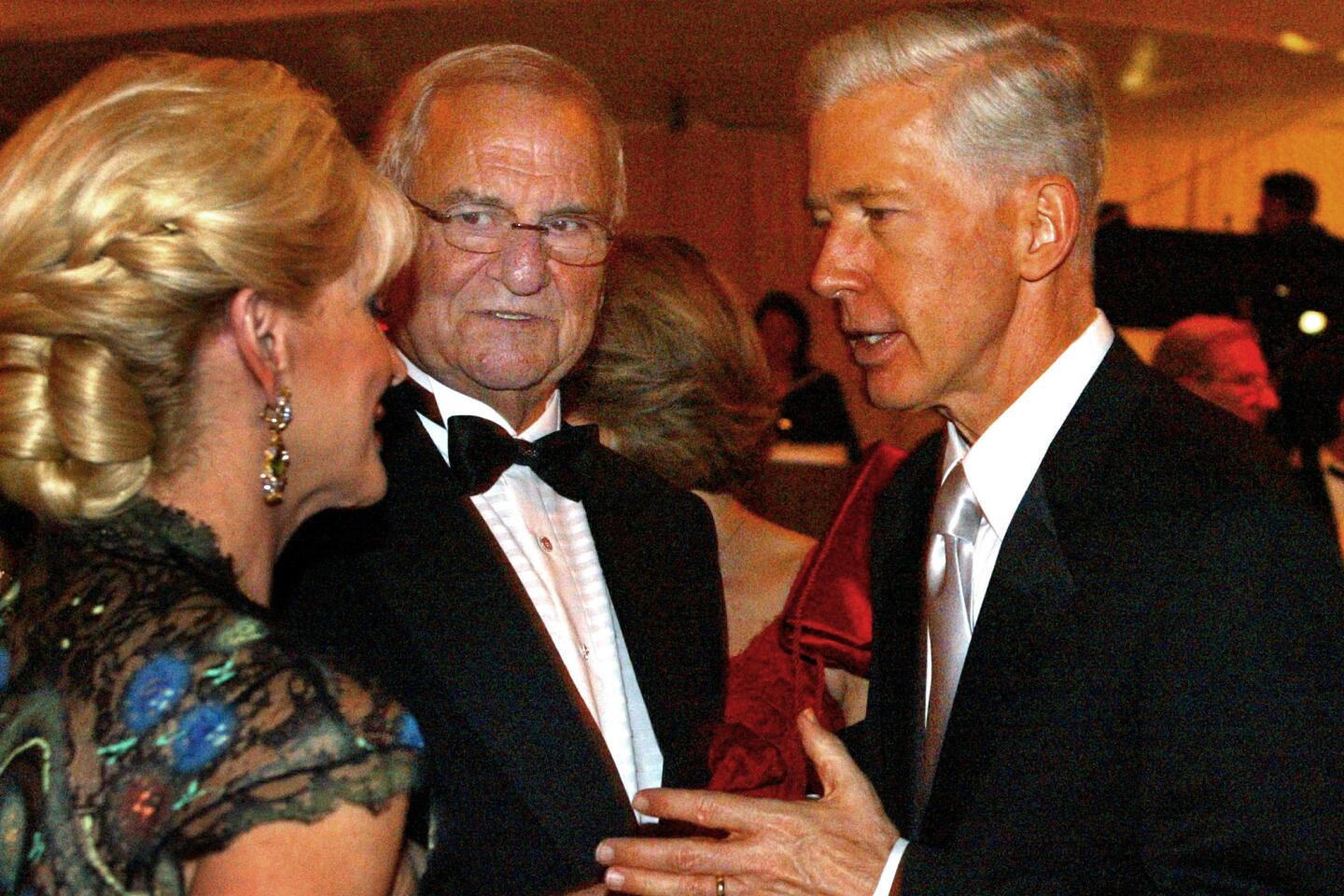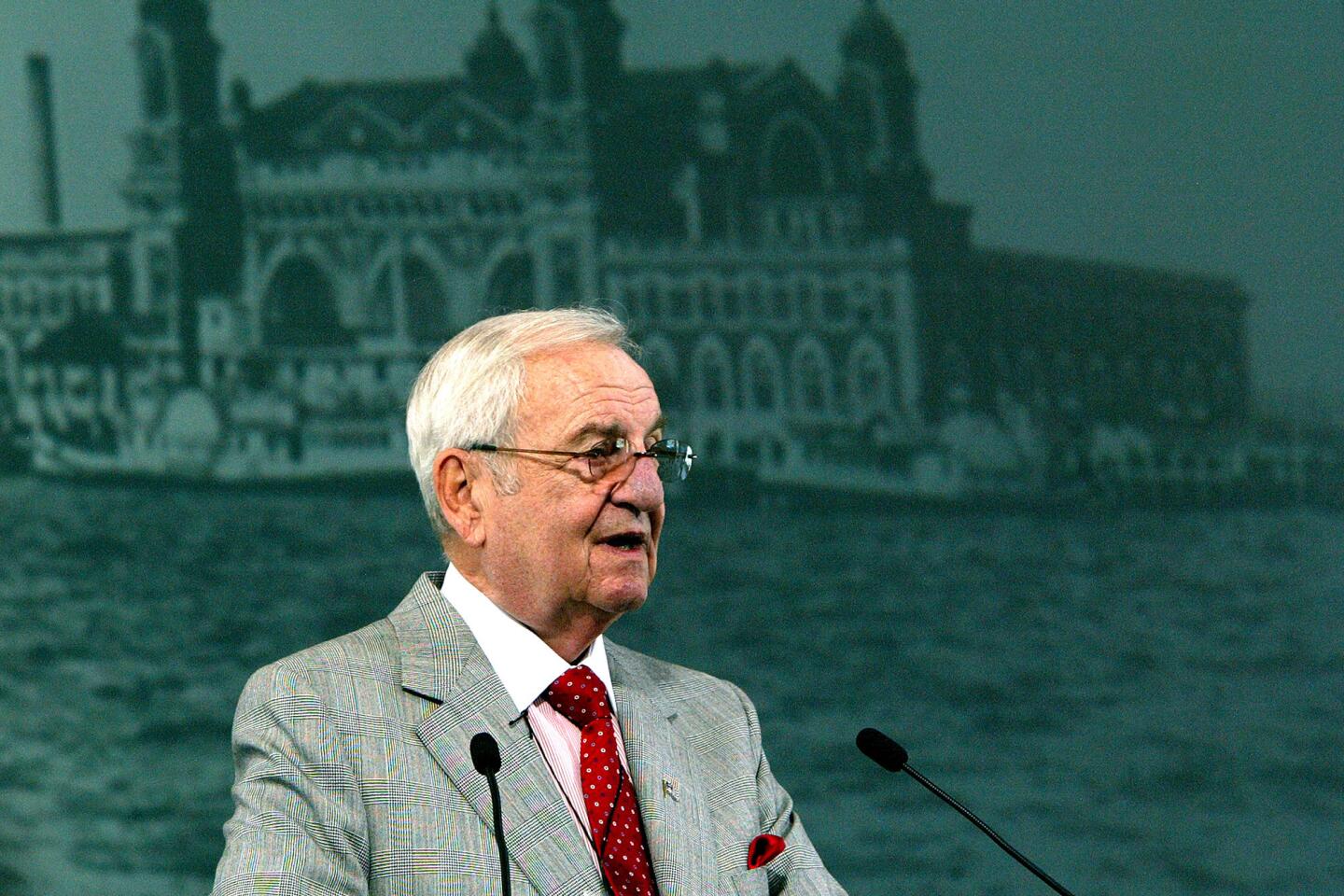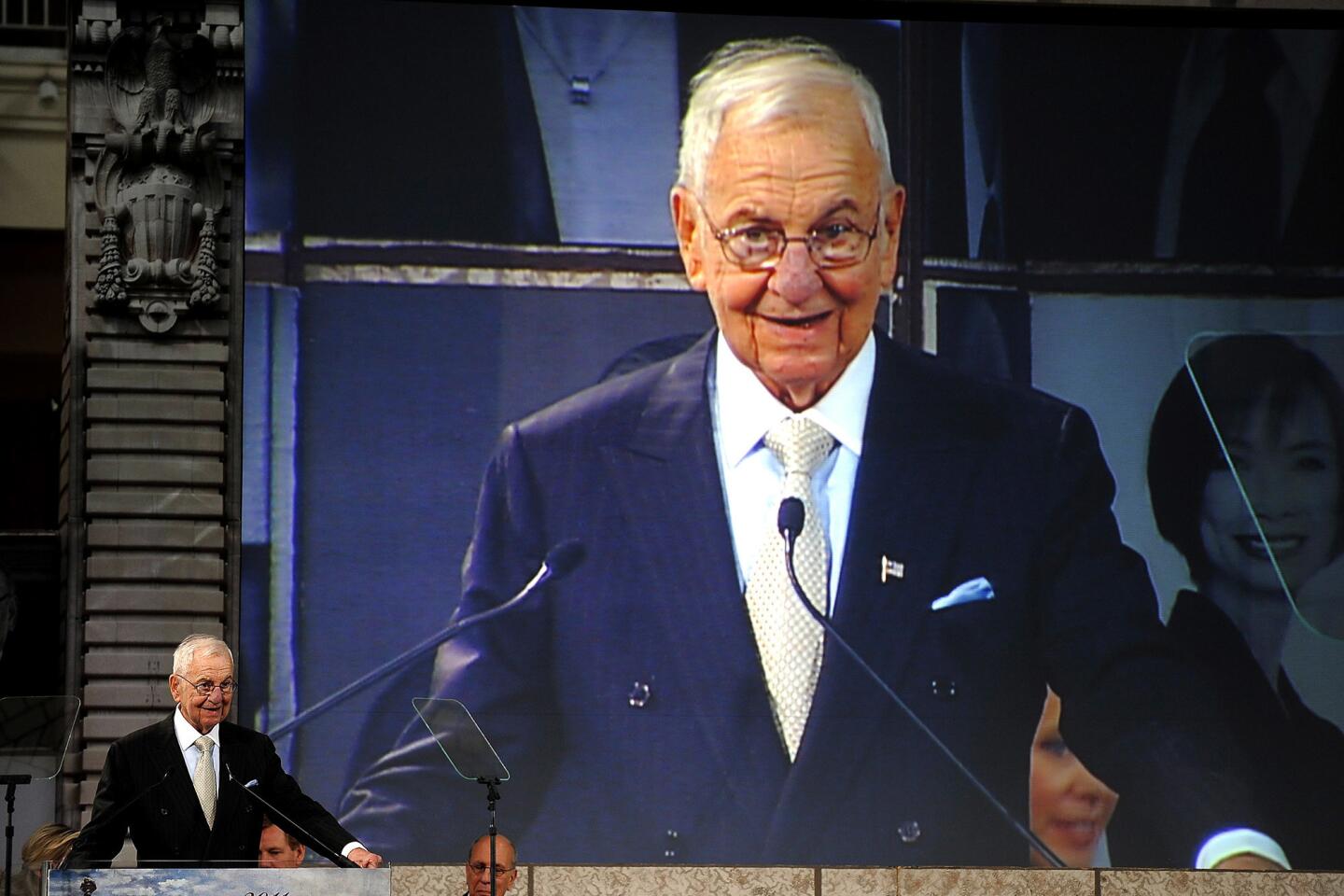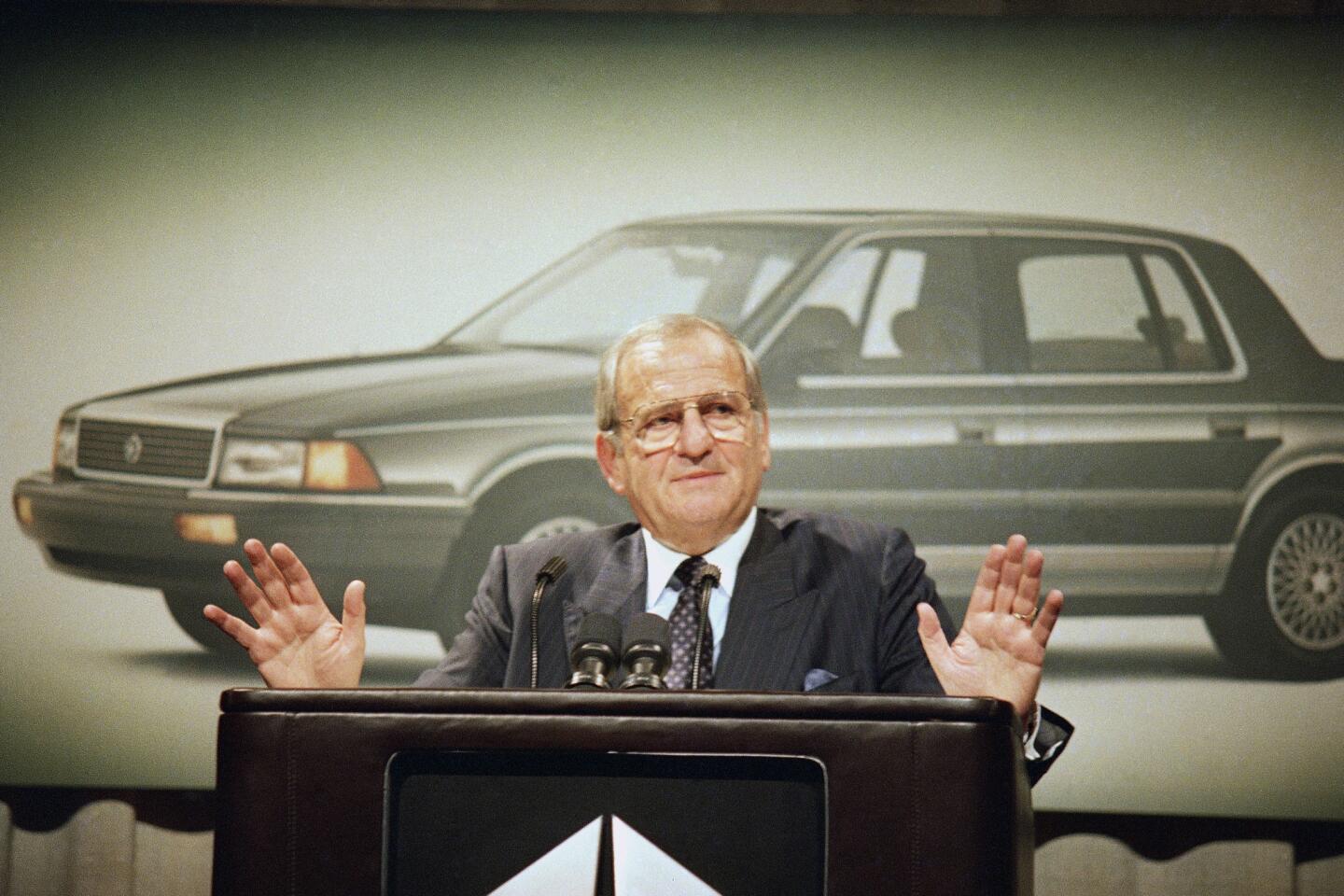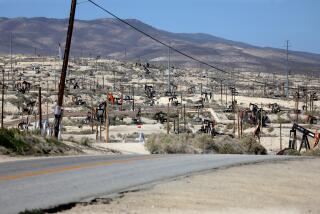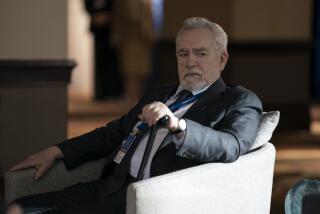Lee Iacocca, father of the Ford Mustang who later rescued Chrysler, dies at 94
- Share via
Lee A. Iacocca, an ambitious immigrant’s son and salesman extraordinaire whose blunt and swaggering persona dominated the automobile industry like nobody since Henry Ford, died Tuesday. He was 94.
Iacocca, who spent his last years living in Los Angeles, died Tuesday morning at his Bel-Air home from complications of Parkinson’s disease, according to a family spokeswoman.
Iacocca hacked out a spectacular career, punctuated by his role as father of the wildly popular Ford Mustang in 1964, his epic 1978 firing at the hands of Henry Ford II and his dramatic rescue of Chrysler in the early 1980s.
A powerful speaker with ego to spare, Iacocca became a heroic figure to millions of Americans. He also became a household name by starring in Chrysler’s television commercials, where he pointed a finger at viewers and delivered a sales pitch that entered the lexicon: “If you can find a better car, buy it.”
But Iacocca also attracted countless critics who considered him a hypocrite and self-promoter, and saw his downfall from the presidency of Ford Motor Co. as just deserts for what they viewed as his Machiavellian scheme to reach the top.
In a characteristic response, Iacocca snapped in a 1992 interview with The Times: “Machiavelli, my ass.”
But few dispute his subsequent achievement at Chrysler. He took over a decrepit company that was moments from bankruptcy, persuaded Congress to guarantee $1.5 billion in loans to launch its new “K-car” and extracted big sacrifices from workers, dealers, bankers and suppliers. Chrysler regained its health, and Iacocca triumphantly paid back the government loans seven years early.
Fiercely debated across the nation as Iacocca jawboned Congress into backing the company, the corporate bailout and TV ads gave him a visibility that was unprecedented for a businessman in modern times.
“He was easily one of the greatest figures in the history of the automobile industry,” said David Lewis, a professor emeritus of business history and Ford expert at the University of Michigan. “And he was second only to [the first] Henry Ford in the amount of publicity he generated.”
Iacocca exploited his high visibility to attack U.S. and Japanese policies that he said were killing American jobs. The message hit home as factories closed by the thousands in the 1980s and the nation’s economy seemed to wither in the face of competition from Japan.
Two phenomenally successful books and Iacocca’s leadership of a money-raising blitz to refurbish the Statue of Liberty and Ellis Island in the mid-1980s further honed his image as a patriot and champion of working people, and prominent Democrats seriously touted him as a candidate for the White House.
But he recognized that his dictatorial and often profane style wasn’t suited for politics. He publicly discouraged talk of the presidency and later turned down an appointment to the U.S. Senate from his home state of Pennsylvania.
Iacocca’s name and face turned up so often that he entered pop culture and some wearied of him. Besides his commercials, he made a cameo appearance on the TV series “Miami Vice” and turned down an offer to host “Saturday Night Live.” Chrysler’s ad agency even test-marketed a commercial starring an Iacocca Muppet bantering with Kermit and Miss Piggy.
By the late 1980s, new problems, some traceable to Iacocca mistakes, threatened Chrysler anew and he came under fire from Wall Street. Part of the solution was to eliminate thousands more jobs while he collected enormous paychecks, and his image with Democrats and labor suffered.
Meanwhile, his strident attacks on Japanese trade policy, even as he imported Japanese cars for Chrysler, offended many who saw his speeches as racist and self-serving. And sentiment turned against an auto industry that was seen as having mismanaged itself into trouble once again.
But by the time he retired as chairman of Chrysler on Dec. 31, 1992, he had overseen a second and more fundamental turnaround.
A series of dramatically styled cars and trucks, developed on Iacocca’s watch in radically new ways, made Chrysler the hottest — and most profitable — auto company of the mid-1990s.
That was how he wanted to be measured, he said at his retirement. “It’s a hell of a note,” he added, “but I have a feeling I’m going to be remembered only for my TV commercials.”
In retirement, Iacocca joined with the late billionaire Kirk Kerkorian in an abortive effort to take over Chrysler, made an unlikely assortment of investments and went through a second divorce.
He maintained homes on L.A.’s Westside and in Indian Wells, Aspen, Colo., Detroit and the Tuscany region of Italy, where he owned a small estate and winery, Villa Nicola, named after his father.
He also formed Iacocca Capital Group, a merchant banking firm, and invested in ventures including gaming, the emerging space industry and a theater and restaurant complex in Branson, Mo., the mecca for country and western music.
He also had established the Iacocca Institute to improve executive leadership with his alma mater Lehigh University in Bethlehem, Pa.
Iacocca leaves two daughters, Kathi and Lia, by his first wife, Mary, who died in 1983 from complications from diabetes. The Iacocca Family Foundation, which funds diabetes research, was founded the next year in her honor.
A brief second marriage to Peggy Johnson ended in divorce. He married Los Angeles restaurateur Darrien Earle in 1991, but that union also ended in divorce.
Born Lido Anthony Iacocca in Allentown, Pa., on Oct. 15, 1924, he was the son of Nicola and Antoinette Iacocca, both natives of San Marco, Italy. The elder Iacocca supported the family with a movie theater, a hot-dog stand and a car-rental agency.
In his 1984 autobiography, “Iacocca,” the auto executive said he inherited his promotional instinct from his father. Nicola once enticed a horde of youngsters to his movie theater by offering free admission to the 10 kids with the dirtiest faces.
But the family lost everything during the Depression, an experience Iacocca said he never forgot. Like many who lived through those years, he said it instilled a mania for success and, especially, for money.
“The Depression turned me into a materialist. I was after the bucks,” he said, a mission he completed grandly. Cheered for taking a $1 salary when Chrysler was in trouble, he was castigated for taking home as much as $20 million a year when the company had recovered.
“No matter what you have,” he once said, “it’s never enough.”
Iacocca also spoke of bigotry aimed at Italian Americans when he was growing up in Allentown. That was another part of his makeup, later fueling a resentment of the Anglo-Saxon, old-money Ford family that blocked his way to the Ford Motor chairmanship.
Iacocca rolled through the public schools and was exempted from military service in World War II because of a childhood case of rheumatic fever — an exemption he considered a “disgrace.” He graduated from Lehigh University in three years, earned a master’s degree in engineering at Princeton, and joined Ford as an engineering trainee in 1946.
He quickly asked to be transferred to sales, and by 1956 his labors at a regional sales office in Pennsylvania attracted the attention of Robert McNamara, then the head of the company’s Ford Division. McNamara brought Iacocca to the headquarters in Dearborn, Mich.
McNamara, headed for bigger things himself, was pivotal to Iacocca’s rapid advancement. McNamara became president of Ford in 1960 and within two weeks was tapped by newly elected President Kennedy to become Secretary of Defense.
McNamara later became president of the World Bank. One of McNamara’s last acts at Ford was to recommend that Iacocca become, at 36, the youngest vice president in Ford’s history.
That was his platform for orchestrating the new Mustang, a refigured Ford Falcon with a sporty flair. Iacocca had to overcome the doubts of Chairman Henry Ford II, grandson of the auto pioneer, who had taken over the company’s reins from his senile grandfather during World War II.
Henry Ford was nervous about funding the Mustang after the company’s Edsel debacle of 1957. But the new model sold 419,000 copies the first year and became one of Detroit’s biggest success stories.
That was when America was first confronted with the Iacocca phenomenon. In a memorable publicity coup by a Ford press agent, Iacocca and the new Mustang appeared simultaneously on the magazine covers of Time and Newsweek the day the car went on sale.
The articles amounted to unpaid commercials for both the car and the man. Iacocca — rhymes with “Try-a-Coke-ah,” Time explained — would later credit the stories with generating sales of an extra 100,000 Mustangs. They also created the impression that the Mustang was virtually a one-man feat and forged the tough Iacocca image. He was, Newsweek gushed, “as direct as the thrust of a piston.”
Iacocca continued to move up at Ford, pulling together a burgeoning group of intense loyalists in what he later called “a mad rush for the top.” But Henry Ford II shocked him and the rest of the auto industry in 1968 by raiding General Motors for his next president, Semon “Bunkie” Knudsen. A poor fit at Ford, Knudsen was fired by Henry Ford within 18 months and Iacocca was named president.
In his autobiography, Iacocca said Knudsen’s ouster made him wonder “if this was in store for me.” But many Ford insiders believed Iacocca had skillfully wielded a scalpel that undercut Knudsen. Thus the Iacocca legend grew.
With Henry Ford II as chairman and chief executive and Iacocca as president, Ford Motor maneuvered past the Arab oil embargo, regulatory pitfalls and other events of the 1970s while building a large and profitable European subsidiary.
What drove the two apart is still grist for argument in books and Detroit barrooms.
In an industry of Midwestern blandness, both men stood apart. Iacocca had never been a Detroit insider. His tastes ran to New York and Italy, and his friends were an unlikely bunch: George Steinbrenner, the controversial shipping magnate and owner of the New York Yankees, and singers Vic Damone and Frank Sinatra.
Henry Ford II, meanwhile, represented a family of the sort that passed for royalty in America. Namesake of the genius who started it all, he never let his executives get close. His name was on the building and his family controlled 40% of the Ford Motor stock.
In his sometimes bitter memoirs, Iacocca called Henry an evil despot and boorish drunk who was bigoted, paranoid about “palace revolts” and frightened of strong executives. Those close to Ford said he viewed Iacocca as grasping, provincial and dangerously ambitious.
Ford ordered an internal investigation of Iacocca, apparently looking for evidence of fraud, gambling or other unseemly behavior, but turned up nothing. Relations between the two deteriorated.
In July 1978, Iacocca was summoned to the chairman’s office where Henry, flanked by his brother, William Clay Ford, said, “I think you should leave. ... Sometimes you just don’t like somebody.”
But that is Iacocca’s account. Walter Hayes wrote in the 1990 book “Henry” that Iacocca had tried to enlist board members in a coup attempt while Henry was out of the country.
That episode — confirmed by the late Franklin D. Murphy, then a Ford director and chairman of the former Times Mirror Co., then-publisher of The Times — triggered the firing, Hayes wrote.
The showdown between the two seemed scripted by Hollywood and quickly assumed the proportions of corporate legend. Biographers waxed lyrical, including Robert Lacey, author of “Ford: The Men and the Machine,” who wrote of “this final, skull-jarring encounter between two bull males, each so potent, so talented, and so raging mad.”
The closest Ford, known as a womanizer and serious drinker, explained to another author that the firing was a more prosaic comment about Iacocca: “He was not morally qualified to be chief executive of Ford Motor Company.”
Nor was Ford Motor Co. in very good shape in its all-important U.S. operations — Iacocca’s direct responsibility — when he was fired. That became clear when the Iranian revolution in 1979 sent oil prices soaring, and Ford’s new-car pipeline was found to be almost empty. By 1981, Ford was in deep financial trouble. The Iacocca and Henry Ford camps still blame each other for that fact.
After the showdown, Iacocca was shunted off to a warehouse office, where a group of reporters greeted him. It was the low point of his life, he said later: “It was enough to make me want to kill.”
But within days, Chrysler came calling. Run into the ground by a series of finance-trained chairmen, the third-biggest U.S. auto company was in such bad shape that, Iacocca said later, had he known the truth he would never have taken the job.
He inherited a lineup of cars that were rusting out from underneath their owners and a chaotic system in which the factories built cars whether people wanted them or not. Vast parking lots around Detroit were filled with new, unwanted Dodges and Plymouths, running a tab of millions of dollars a day in double-digit borrowing costs at a time of double-digit inflation.
No bank would lend Chrysler money, and Iacocca — who for years had railed against federal intervention in the auto industry — lobbied Washington in a memorable display of chutzpah and skill. He employed a spellbinding style that he credited, improbably, to a high school Dale Carnegie course.
“Iacocca used written texts the way Leonard Bernstein used musical notation,” Hayes said.
In a warning that was largely borne out, Iacocca told lawmakers that Chrysler was just the leading edge of an economic crisis that would ripple through industrial America. And, he pointed out, Chrysler was the nation’s biggest private employer of African Americans.
Backed by President Carter and such traditional Democratic constituents as organized labor and the Congressional Black Caucus — and with Democratic campaign contributions wrung from Chrysler dealers, suppliers and others — Iacocca got the government to guarantee $1.5 billion in loans that he used to launch two new models, the Plymouth Reliant and Dodge Aries.
He then began a marketing blitz that wrapped the cars in the American flag, managing to create a social conscience around Chrysler.
“He was always selling something. A product, an idea, himself,” Lewis, the historian, said. “He was one of the greatest salesmen in American business history.”
Within three years, Chrysler was earning record profits. And in a vintage I-told-you-so appearance at the National Press Club in 1983, Iacocca announced he was paying back the guaranteed loans seven years ahead of time. The government collected millions of dollars in fees on the deal.
Though 1984 saw the introduction of the minivan, Chrysler’s landmark highly successful reinvention of the family sedan, Iacocca, by his own admission, was making mistakes amid prosperity that imperiled the company again.
The firm spent hundreds of millions of dollars on non-auto ventures, skimped on new-car investment, and almost choked to death on American Motors Corp., the auto producer it bought to get its Jeep subsidiary.
But Iacocca anticipated the 1990-92 recession sooner than his competitors and prepared for it by cutting $3 billion in costs out of the company, even as he was building a new $1-billion technical center north of Detroit and a $1-billion assembly plant in one of Detroit’s worst economically disadvantaged neighborhood.
Putting all its stylists, engineers and other key people under one roof at the glitzy technical center, Chrysler turned Detroit’s cumbersome car-development process upside down and began bringing autos out ahead of time and under budget.
The results included such successes as the “LH” sedans, typified by the Dodge Intrepid; the Jeep Grand Cherokee and a dramatically styled new Dodge Ram pickup truck, and the subcompact Neon.
These models came out as the Japanese economy and some of its leading auto companies stumbled — “It couldn’t happen to a nicer bunch of guys,” Iacocca cracked — and the once-moribund Chrysler under the leadership of his hand-picked management team led the industry in profitability in 1993.
“When I got here it was crisis time, and I guess I don’t fold under heat and I was a good crisis manager,” Iacocca told The Times in 1992. “Then people wrote that when things go well, I’m a lousy manager. Well, that’s OK. Times do change and you adapt or you die. We survived and we survived happily.”
In retirement, Iacocca left Detroit for California, where his third marriage deteriorated in nasty fashion. “You never want to retire, move to a foreign country [California] and get divorced at the same time. That’ll kill you,” he said.
He threw his money and name behind an odd assortment of enterprises, including electric bicycles, the Koo Koo Roo Chicken restaurant chain and an olive-oil concoction called Olivio Spread, produced from the olive trees on his Tuscany estate.
He traveled the country like a pitchman, talking up his products to anyone who would listen, sometimes to sparse audiences.
In 1995, Iacocca joined with investor Kerkorian in a quixotic bid to take over Chrysler, sharply criticizing the automaker and accusing it of refusing to honor his options on more than 100,000 shares of stock.
Ironically, three years later, Chrysler did what Iacocca had tried desperately to do in the 1980s — merge with a foreign auto company. Soon Iacocca was offering advice to the new, German-owned DaimlerChrysler. He said he met several times with then-Chairman Juergen Schrempp about a possible role at the company.
But Schrempp “stiffed” him, Iacocca said in 2002. “Schrempp doesn’t want to be upstaged by even the aura of having me around,” he said.
Chrysler now is part of the holding company Fiat Chrysler Automobiles NV.
In addition to his two daughters, Iacocca’s survivors include by eight grandchildren.
Woutat is a former Times staff writer.
More to Read
Start your day right
Sign up for Essential California for the L.A. Times biggest news, features and recommendations in your inbox six days a week.
You may occasionally receive promotional content from the Los Angeles Times.
